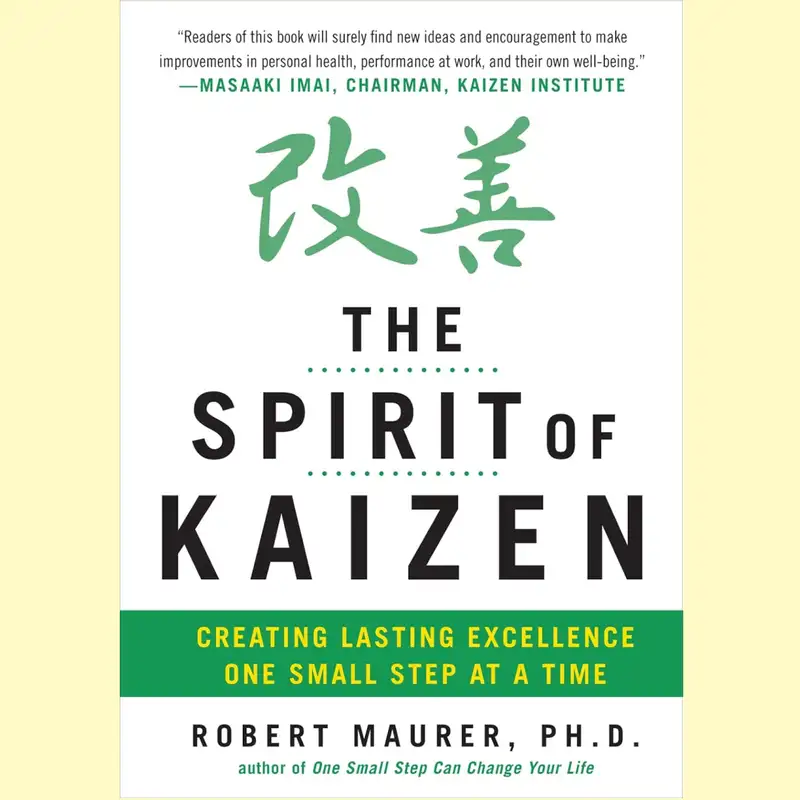The Spirit of Kaizen by Robert Maurer
Summary: The Spirit of Kaizen by Robert Maurer
Summary: The Spirit of Kaizen by Robert Maurer
In The Spirit of Kaizen, Robert Maurer introduces readers to a powerful philosophy of change: the idea that meaningful improvement is best achieved through small, steady steps. Kaizen, a Japanese term meaning “continuous improvement,” has become a cornerstone of business and personal growth strategies, advocating for a process-oriented mindset that emphasizes the value of small changes over grand, sweeping transformations. This approach can foster sustainable growth, reduce psychological resistance, and help people overcome barriers like procrastination and anxiety.
Kaizen offers a practical and compassionate path to change, whether applied to business, personal development, or daily routines. Maurer’s work provides actionable steps and insights into how even minor adjustments can lead to significant, lasting success.
Audio Summary: The Spirit of Kaizen by Robert Maurer
Embracing the Small Steps Approach
Maurer’s Kaizen philosophy rests on breaking down tasks into small, manageable steps. He argues that taking giant steps can often be overwhelming and cause people to give up before they start. However, people can begin to build momentum by focusing on incremental improvements. “Great change begins with one small step,” Maurer writes, highlighting that even minor actions can accumulate to yield powerful results over time.
Maurer illustrates this concept with various examples, such as encouraging a person who wants to exercise more to start by committing to just one minute of activity each day. Over time, this tiny habit becomes ingrained, and the person can build upon it. The key is to reduce the initial barrier to change so it feels achievable rather than intimidating.
Reducing Resistance to Change
One of the biggest obstacles to change is our brain’s natural resistance. Maurer explains that when faced with a significant, daunting goal, our brain may trigger a fear response, effectively paralyzing us from progressing. This response is why so many resolutions and big plans fall apart—they can feel too overwhelming to tackle.
Maurer’s Kaizen approach seeks to circumvent this fear by taking tiny steps that feel non-threatening. For instance, if someone wants to start a meditation practice, rather than setting a goal of 30 minutes daily, Kaizen encourages them to begin with just one deep breath. This minuscule step is not only easy to do but is also non-intimidating, allowing the person to build on it without fear gradually. “When we take small steps, our brains are less likely to activate the fear response,” Maurer notes, emphasizing that Kaizen is as much about psychology as it is about process.
Sign up for Apollo Advisors: Workshops, Mentorship and Masterclasses for Entrepreneurs
Align Your Leadership, Execute Your Vision, Scale Your Business
No spam. Unsubscribe anytime.
Building Lasting Habits Through Kaizen
Building habits is essential for personal and professional growth, yet it often requires consistent effort to ensure that these habits endure. Maurer argues that the kaizen philosophy efficiently creates lasting habits because it doesn’t require a drastic overhaul of behavior. Instead, it reinforces change gradually, helping to build long-term consistency.
Maurer explains how Kaizen helps to "rewire" the brain by repeating small actions that eventually become second nature. For example, if someone aims to improve their communication skills, they might spend five minutes each day writing a journal entry about their thoughts and interactions. This practice, done consistently over time, can lead to more open communication skills, as it helps build a foundation without requiring a drastic change in behavior.
Overcoming Procrastination and Anxiety
Procrastination and anxiety can be significant barriers to change, often resulting from a fear of failure or a sense of being overwhelmed by large tasks. Maurer provides techniques to overcome these issues by focusing on taking the “smallest possible step.” He suggests that people can reduce the mental resistance to starting by making the initial task as simple as possible.
For example, if someone avoids a big project, Kaizen encourages them to spend just five minutes on it. This simple action makes the task feel less daunting and lowers the entry point to action, making it easier to overcome procrastination. “Start where you are, and take the smallest step possible,” Maurer advises, highlighting that even five minutes of focused effort can build momentum and ease the mental burden of large tasks.
Kaizen in Business and Personal Life
Kaizen is not just a personal development tool; it’s a philosophy that has transformed businesses worldwide. Maurer discusses how companies like Toyota have embedded Kaizen principles into their culture to encourage continuous improvement in every department and level. Companies can increase efficiency, reduce waste, and foster collaboration and growth by emphasizing minor, ongoing improvements.
Maurer provides insights into how Kaizen principles can be applied to personal relationships and daily routines. In a relationship, for example, a couple might start by setting aside five minutes each day to discuss their day, gradually building deeper communication over time. Likewise, Kaizen can be applied to self-care practices, helping people to improve areas like diet, exercise, or mindfulness by taking tiny, consistent steps.
red and black walkway
Practical Tool: Kaizen-Based Checklist for Implementing Small Steps
To make Kaizen actionable, here’s a step-by-step checklist for incorporating minor, incremental improvements into daily life:
Identify One Area to Improve
Example: Choose a single area, like time management or physical health.
Set a Tiny Goal
Example: If you focus on physical health, set a tiny goal, such as one minute of stretching each morning.
Establish a Routine
Example: Attach this new habit to an existing routine. For instance, do your minute of stretching immediately after brushing your teeth.
Track Your Progress
Example: Keep a small calendar and mark each day you complete your one-minute task. This reinforces consistency.
Evaluate and Adjust
Example: After a week, assess how the task feels. If it’s easy, consider adding another minute or a similar task to complement it.
Celebrate Small Wins
Example: Reward yourself for every milestone, no matter how small. Acknowledge these achievements as they build motivation.
Add Gradual Increases
Example: Once you’re comfortable, increase the activity level—from one minute to three minutes of stretching daily.
By following these steps, the Kaizen method makes change manageable and removes the need for drastic actions that often feel overwhelming.
Author Biography: Robert Maurer
Robert Maurer is a clinical psychologist, author, and behavioral sciences expert focusing on organizational and personal change. With a background in clinical psychology and extensive experience in Western and Eastern philosophies, Maurer has pioneered ways to integrate psychological strategies into personal growth and organizational success.
He is a popular keynote speaker and consultant for Fortune 500 companies, healthcare organizations, and universities. He shares Kaizen techniques that help people overcome barriers and reach their goals. Maurer’s work emphasizes the simplicity and effectiveness of small, consistent steps, making him a respected voice in the world of self-improvement and business excellence.

